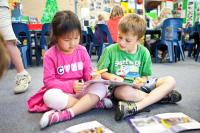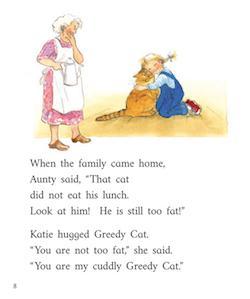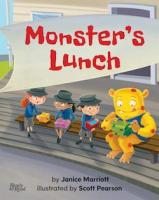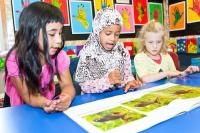Reading and writing sessions, including the times when students work on independent tasks, are excellent opportunities for explicit instruction and focused discussion as the group explores how language works.
Learning through Talk, page 70
The previous suggestions have focused on aural activities and on students building their knowledge of letter–sound relationships. This section focuses on students applying their awareness and knowledge of spoken language when reading and writing. Students may need explicit instruction to show them how they can draw on this knowledge. This section ends with suggestions for games and activities you can use to reinforce students’ learning. You can find many more suggestions in the Ready to Read teacher support materials.
Reading
The reading focus in years 1–3 is for students to become competent, confident, and enthusiastic readers and learners. Each student builds a reading processing system that becomes self-extending, enabling them to operate effectively across a range of increasingly complex texts. The processing system involves using multiple sources of information (semantic, syntactic, and visual) together with prior knowledge to make meaning of the text.
Shared reading, guided reading, and after-reading activities (as described in the teacher support materials for guided texts) provide many opportunities for students to build and apply their knowledge of sounds, letters, and words as they build their reading processing systems.
Make use of opportunities in shared and guided reading and writing to draw attention to inflected word endings. For example, to draw attention to “ed” with students reading at Yellow, you could write the sentence “Katie hugged Greedy Cat” (from Lunch for Greedy Cat). Ask the students to suggest other things that Katie could have done (such as “cuddled”, “loved”, “kissed”, or “squeezed”). Write the students’ suggestions above the focus word and read the new sentences. Ask the students to underline the “ed” endings. (Students will often hear the final “ed” as a “t” sound, so when they are reading and writing, they need to see it in its written form on many occasions.)
As well as drawing attention to particular features, be on the lookout for “teachable moments” as students make discoveries (such as that “ph” has an “f” sound in “elephant”). Students are more likely to make connections between their developing knowledge of letter–sound relationships and their reading and writing of texts if they are engaged and involved in making discoveries for themselves.
You can draw attention to words that start (or end) with a specific letter, digraph, or consonant blend in a familiar shared book or poem, for example:
- using the poem card, Pease Porridge: What sound can you hear at the beginning of “porridge”? What letter makes the sound? Ask the students to listen for (and find) another “p” word while you reread the rhyme.
- using the poem card, Just a Touch: There are two letters that make up the beginning sound of “snail”. What sounds can you hear? Support the students in listing other words that start like “snail” (“sneeze”, “snake”, “snore”).
- using the poem card, Nanny: Reread the second-to-last line (“Snip snap, snip snap”). What sound can you hear at the end of these words? Have the students reread the line with you, emphasising the final sounds. Repeat the activity with lines three and five (“Criss cross, criss cross” and “Zig zag, zig zag”). Together, reread the whole poem, relishing the repetition of the end sounds. (The students may also notice the “g” sound at the end of “schoolbag”.)
When students come across unfamiliar words during guided reading, as well as drawing on their ideas about meaning and language structure, use prompts that encourage them to think about what they already know that can help them. Useful prompts and questions include:
- Look for something that will help you. What can you see that might help? Do you know another word that starts with the same letter? Check it. Does it look right and sound like that? Have a close look at the word. Is there a part that you know?
- If the word was ________, what would you expect to see? (in response to an approximation by the student). Does that look right?
For more examples of useful prompts and questions, see Effective Literacy Practice in Years 1 to 4, pages 128–130.
Writing
When writing, students need to be able to hear the sounds in words before they can attempt to write them. Teacher modelling of the slow stretching of words during shared writing provides explicit opportunities for developing students’ abilities to hear and articulate the sequence of sounds within words. (If some students have difficulty distinguishing or articulating sounds, see Learning through Talk pages 31–38 and 70–71 for further information.)
Writing requires the child to pay close attention to the words he has chosen to write in his story, to hear the sounds in those words and to write down letters that will represent those sounds. It is an activity well suited to developing phonemic awareness.
Clay 2016, page 93
Shared writing provides opportunities to demonstrate a variety of ways of constructing words and to show students how they can draw upon their existing knowledge. Model ways of writing new words so that the students feel confident in attempting them when writing independently. Here is an example of the learning opportunities involved in constructing just one sentence.
The students at the school have been working on an art display that is currently on show at the local shopping mall. A class of year 1 students have walked to the mall to see the display and are now recording their experience together. They’ve decided to begin the shared writing text with: “We saw the art display at the mall.” As the class works through the sentence, the teacher varies her prompts according to what she knows about the students’ phonological awareness and their word and letter–sound knowledge.
“We”, “the”, “at” – The teacher draws on the students’ knowledge of high-frequency words.
“saw” – The teacher asks the students to identify the initial sound, but she tells them the rest of word because she knows that “saw” is not a word they are familiar with in its written form.
“art” – The students know this word because of the art display and their preparation for it; also, there are labels in the classroom.
“display” – The teacher asks the students to break the word into syllables (orally: clapping the parts). She asks the students to sound out “dis”. They need a bit of support with “i” so the teacher tells them it’s the same sound as in “is” and “in”. She draws on their word knowledge (visual memory) for “play”.
“mall” – The teacher asks the students to identify the initial sound and draws on their knowledge of “all” to complete the word.d
Constructing this sentence has drawn on the students’:
- knowledge of familiar words (their visual memory)
- ability to differentiate initial, medial, and final sounds and to match letters to those sounds
- knowledge of the “all” rime
- ability to break words into syllables.
Teaching and learning sequences like this demonstrate to students how much they know about sounds, letters, and words and how they can draw on this knowledge in their independent writing. Use questions and prompts that help students make connections with previous learning. For example, if a student needs help to write the word “cooking”, remind the student of what he or she already knows. You know how to write “look”. How could you change “look” into “cook”? What letters do you need to write “ing”?
Other examples:
- What sound can you hear at the beginning/end of the word?
- It starts like ________. You know the letter that ________ starts with.
- Can you find a picture on the alphabet card that starts with the same sound?
- You’ve got the beginning and end sounds. Now what about the sound in the middle? Provide examples for the student if he or she needs help to make the connection.
- Can you hear a part that you know? That’s right, it’s got “and” in it. You know how to write “and”.
Note that while the ability to aurally distinguish phonemes helps build understanding of how language works, it is important that, when reading and writing, students look or listen for the biggest known chunks of words:
[A] writer who knows “lunch” is able to work out “munch” by using the spelling pattern that represents the rime “unch”. This chunking of information is generally much more successful than trying to sound out a word letter by letter or thinking of one letter at a time when writing.
Effective Literacy Practice in Years 1 to 4, page 36
Spelling
As students begin to acquire a store of automatically produced and recognised words through daily writing, you can introduce simple spelling activities and short lists of words for them to learn. Spelling words for students to learn should be words that they are likely to use often. These will include:
- high-frequency words
- words that have a similar pattern, such as a shared rime
- words from the students’ writing that they can almost spell
- words that are of high interest to the students.
It is helpful to have a variety of class-generated word lists, alphabet-based word lists (“ball”, “beach”, “boy” …), verb-family lists (“help”, “helps”, “helping”), and dictionaries available in the classroom. Lists and other reference materials are more effective if they have been generated in discussion with the students.
Reinforcement activities: Exploring letters, sounds, and words
The following are suggestions for consolidating the students’ language knowledge, including knowledge of letter–sound relationships. You can also adapt the activities suggested in Hearing sounds in spoken words by referring to letter names as well as sounds and by
linking them to reading and writing activities. For example, when creating alliterative phrases together, make the link to print by writing (and illustrating) them for the students to enjoy reading, or when exploring onsets and rimes, use magnetic letters or write the onsets and rimes on cards.
- Play listening games that require students to indicate when they hear the word in a list that starts (or doesn’t start) with a particular letter, digraph, or blend.
- Repeat the “mystery box” activity in the Hearing initial sounds section but use initial letters rather than just initial sounds.
- Play I Spy (I spy with my little eye something that starts with “b”). Follow this with a clue about the mystery word, for example, There are many of these in our classroom. I love reading them to you. As the students gain confidence with the alphabet, you could introduce words starting with digraphs or consonant blends. Once the students have solved several clues, ask a student to be the leader.
- Provide matching activities, for example, matching letters with the words for objects or pictures of objects that start with that letter.
- Using cards, magnetic letters, or digital devices, have the students add initial consonants, digraphs, or consonant blends to a familiar rime to create new words.
- Establish a word wall in the classroom. A word wall is an area of the classroom wall with a space for each letter of the alphabet. As the students discover new words, they or the teacher write the word on a card and add it to the word wall.
- Write a simple consonant-vowel-consonant word such as “tin” on the whiteboard, or make it with magnetic letters. Ask the students to say the word. Now, just say the first sound. If we took away the “t”, what would the word be? If we put a “b” here, what would the word be? Ask the students to replace one letter at a time to make a new word. As they gain confidence with changing the initial letter, encourage them to experiment with changing the final and medial letters, for example, a sequence of one-letter changes could be “tin”, “bin”, “Ben”, “bet”, “wet”.
- Build knowledge of inflected endings by creating class lists, for example, of singular and plural forms of nouns or of nouns that end in “er”, such as “teacher”, “runner”, or “player”.
- Build and display sets of verb families (for example, “walk”, “walks”, “walked”, and “walking”). Use them as a basis for oral language activities (for example, creating oral sentences using particular forms of verbs) and encourage students to refer to them when writing. Support the students in adding new sets as they discover them through their reading.






